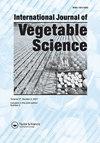Foliar application of iron glutamate improves yield and growth of tomatoes compared to iron sulphate and L-glutamate
IF 1.1
Q2 Agricultural and Biological Sciences
引用次数: 2
Abstract
ABSTRACT Tomato (Solanum lycopersicum L.), grown in iron deficient and calcareous soils, exhibits poor growth and yield loss, which may be moderated using biostimulants. A field experiment was conducted to determine the efficacy of the application of iron glutamate (Fe-Glu), iron sulfate (FeSO4), and L-glutamate (Glu) on growth and yield performance. Foliar application included: no treatment (NS), 0.50% FeSO4, 1% FeSO4, 0.50% Fe-Glu, 1% Fe-Glu, 0.50% L-Glu, or 1% L-Glu. Foliar application of 1% Fe-Glu increased plant height by 31%, shoot fresh weight by 25%, root fresh weight by 38%, and canopy diameter by 23%. Exogenous application with 1% Fe-Glu improved the fruit count and overall yield by 57% and 44%, respectively. There was an increase in fruit length by 20% and an increase in fruit diameter by 25%, respectively, due to foliar application of 1% Fe-Glu. Use of 1% Fe-Glu foliar might act as a better biostimulant than conventional sulfate salts in increasing tomato crop performance.与硫酸铁和谷氨酸相比,叶面施用谷氨酸铁能提高番茄的产量和生长
番茄(Solanum lycopersicum L.)生长在缺铁和钙质土壤中,表现出生长不良和产量损失,这可以通过使用生物刺激剂来缓解。通过田间试验,研究了谷氨酸铁(Fe-Glu)、硫酸铁(FeSO4)和谷氨酸(l -Glu)施用对水稻生长和产量的影响。叶面施用包括:不处理(NS)、0.50% FeSO4、1% FeSO4、0.50% Fe-Glu、1% Fe-Glu、0.50% L-Glu或1% L-Glu。叶面施用1% Fe-Glu可使株高增加31%,梢鲜重增加25%,根鲜重增加38%,冠层直径增加23%。外源施用1% Fe-Glu可使果实数和总产量分别提高57%和44%。叶面施用1% Fe-Glu可使果实长增加20%,果实直径增加25%。在番茄叶面施用1% Fe-Glu可能比常规硫酸盐具有更好的生物刺激素增产作用。
本文章由计算机程序翻译,如有差异,请以英文原文为准。
求助全文
约1分钟内获得全文
求助全文
来源期刊

International Journal of Vegetable Science
Agricultural and Biological Sciences-Plant Science
CiteScore
3.10
自引率
0.00%
发文量
30
期刊介绍:
The International Journal of Vegetable Science features innovative articles on all aspects of vegetable production, including growth regulation, pest management, sustainable production, harvesting, handling, storage, shipping, and final consumption. Researchers, practitioners, and academics present current findings on new crops and protected culture as well as traditional crops, examine marketing trends in the commercial vegetable industry, and address vital issues of concern to breeders, production managers, and processors working in all continents where vegetables are grown.
 求助内容:
求助内容: 应助结果提醒方式:
应助结果提醒方式:


